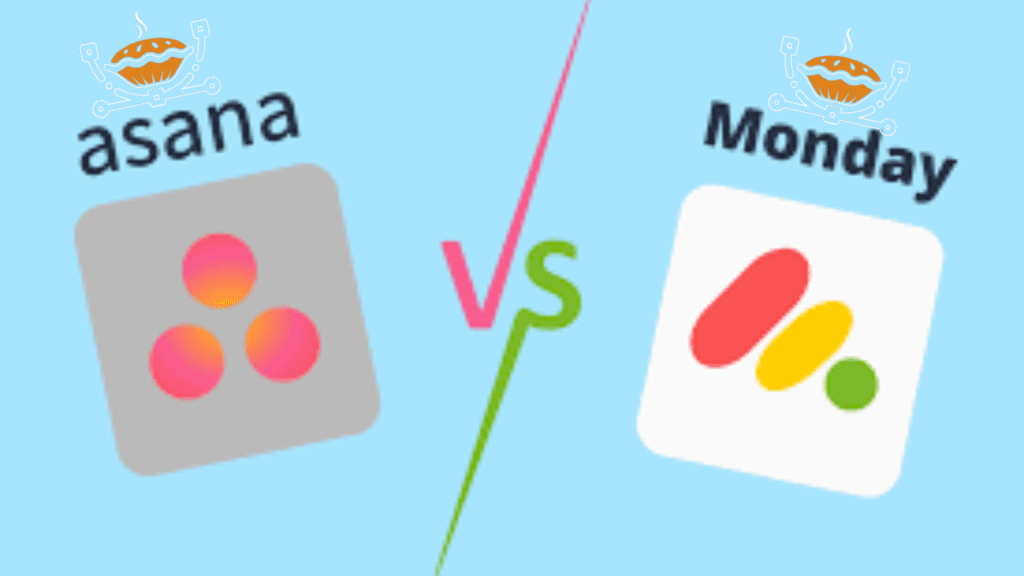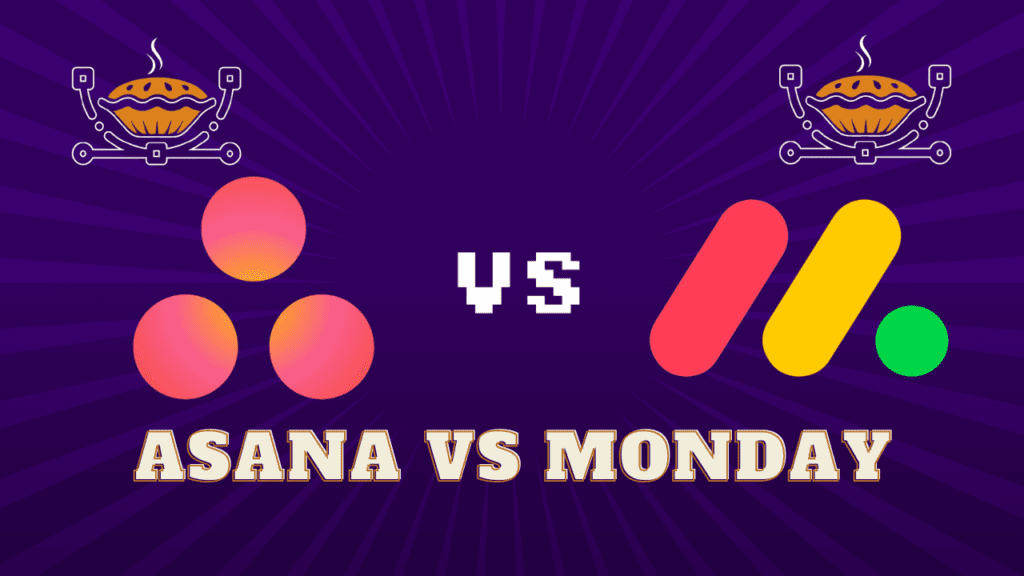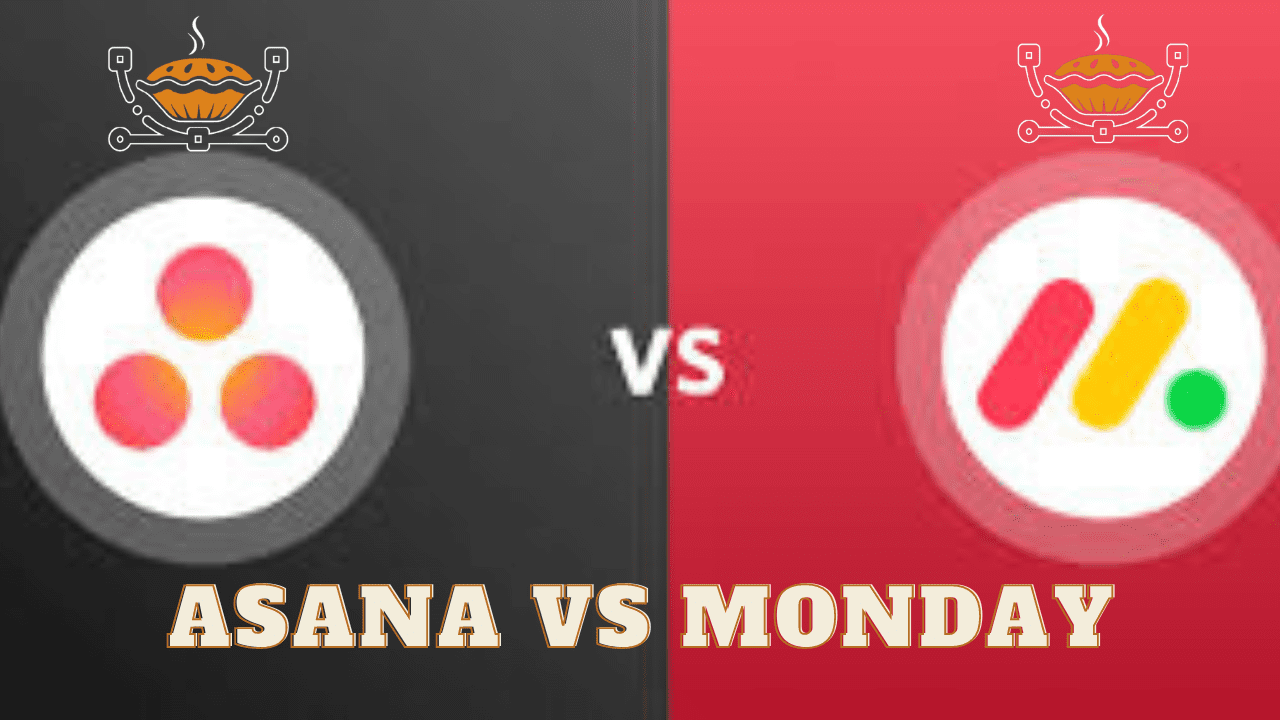Project management tools have become essential for businesses of all sizes to streamline their workflows, improve collaboration, and boost productivity. Among the myriad options available, two popular choices are Asana vs Monday. In this comprehensive guide, we’ll delve into the features, pricing, user experience, and more to help you make an informed decision between Asana and Monday
Let’s compare Asana vs Monday two popular project management apps. Each has its strengths and is tuned for particular use situations. Here’s a rundown of their features and differences.

- Task Management:
- Asana: In Asana, you may create tasks, define goals, assign tasks, and check progress. Tasks can be arranged using lists, boards, or timelines. The “My Tasks” button on the home page allows you to view soon-to-be-completed tasks1.
- monday.com: This platform utilizes the term “pulses” for tasks. You can generate pulses, assign them, and specify task dependencies Asana and Monday. To track progress and completion rates, visit your task manager. Additionally, monday.com has action boards that display task statuses1.
- Pricing:
- Asana: Offers plans ranging from $0 to $24.99 per user per month (paid annually). Enterprise pricing is available upon request.
- monday.com: Plans start at $0 to $19 per seat each month (minimum three seats per plan). Enterprise pricing is also available upon request1.
- Free Plan:
- Asana: Allows limitless users with up to 15GB of storage.
- monday.com: Supports up to two users with 500MB of storage1.
- Offline Accessibility:
- Asana: Available via the mobile app.
- monday.com: Accessible only through the iOS and Android app1.
- Ease of Use:
- Asana: Requires minimal to no technical knowledge and is user-friendly.
- monday.com: Has a slight learning curve but delivers strong analytics2.
- Ideal Use Cases:
- Asana: Best for smaller teams seeking flexible task management.
- monday.com: Suited for modest projects that require quick setup and comprehensive analytics3.
Remember to evaluate your team’s individual needs and goals while deciding amongst these tools
For more thorough information, you can refer to the Forbes Advisor comparison and other resources.
Can you compare their integrations and automations? Asana vs Monday
Certainly! Let’s look into the integrations and automations offered by Asana vs Monday.
- Integrations:
- Asana: Asana boasts an extensive integration ecosystem, seamlessly connecting with over 200 different data and reporting apps. It also supports over 50 communication integrations. Some notable integrations include Slack, Google Drive, Dropbox, Zapier, and Salesforce12.
- monday.com: While monday.com has a respectable number of integrations, it falls short of Asana’s breadth. It currently offers a little over 50 integrations. Keep in mind that monday.com doesn’t allow integrations on its free and Starter plans1.
- Automations:
- Asana: Asana provides robust task management tools overall, including automation features. You can create custom rules and workflows to automate repetitive tasks. For example, you can automatically assign tasks based on certain criteria or set up notifications for specific events.
- monday.com: monday.com is more straightforward in terms of automation. It offers basic automation features, such as setting up triggers and actions. However, it may not be as feature-rich as Asana in this regard3.
In essence, if you emphasize a wide range of integrations and more powerful automation capabilities, Asana might be the superior alternative. However, if simplicity and uncomplicated project management are your aim, monday.com could be a perfect solution for your team13. Remember to consider your team’s specific demands before selecting your pick.
How do they handle user permissions and access control?
Certainly! Let’s see how Asana and monday.com manage user rights and access control:
- Asana:
- User Permissions:
- Asana offers a granular approach to user permissions. You can assign multiple responsibilities to team members, such as Admins, Members, and Guests.
- Admins have complete control over the workspace, including managing users, projects, and settings.
- Members may create, edit, and manage tasks within projects.
- Guests have limited access and can only view specific tasks or projects.
- You can also build custom roles with specified rights.
- Access Control:
- Asana allows you to set project-level permissions. For each project, you may decide who can view, modify, or comment on tasks.
- You can also manage access at the task level by naming collaborators.
- Additionally, Asana provides private projects for sensitive material.
- User Permissions:
- monday.com:
- User Permissions:
- monday.com provides a simpler approach to user permissions. It offers two main roles: Admins and Members.
- Admins have complete control over the workspace, including controlling users, boards, and settings.
- Members can create, modify, and manage items (pulses) within boards.
- Access Control:
- Boards in monday.com can be changed to public, private, or sharing.
- Public boards are accessible to anyone with the link.
- Private boards are restricted to team members only.
- Shareable boards allow you to share specific views with external collaborators without giving them full access to the entire board.
- User Permissions:
In essence, both programs include user rights and access control features, but Asana gives more flexibility in setting custom roles and project-level permissions. Choose the one that corresponds best with your team’s needs.
How do they handle notifications and reminders?
Certainly! Let’s see how Asana and monday.com handle notifications and reminders:
- Asana:
- Notifications:
- Asana provides many notification options to keep users informed:
- In-App Notifications: Users receive notifications within the Asana app when tasks are assigned, due dates approach, or when they’re addressed in comments.
- Email Notifications: Asana offers email notifications for task assignments, due date reminders, and other pertinent events.
- Push Notifications: Mobile app users receive push notifications on their smartphones.
- Customization: Users can change notification settings based on their preferences.
- Asana provides many notification options to keep users informed:
- Reminders:
- Asana allows users to establish due date reminders for tasks. When a task’s due date approaches, users receive reminders via their preferred notification channels.
- Notifications:
- monday.com:
- Notifications:
- monday.com offers the following notification options:
- In-App Notifications: Users receive notifications within the monday.com interface.
- Email Notifications: Users get email notifications for task updates, mentions, and other relevant events.
- Mobile App Notifications: Push notifications are sent to mobile app users.
- Customization: Users can adjust notification settings to their liking.
- monday.com offers the following notification options:
- Reminders:
- monday.com allows users to schedule reminders for specific tasks or pulses. These reminders can be adjusted depending on due dates or other parameters.
- Notifications:
Remember that both solutions seek to keep users informed and on track, but the specifics may vary. Choose the one that corresponds with your team’s communication preferences.
What are their collaboration features?
Certainly! Let’s examine the collaboration features of Asana and monday.com:
- Asana:
- Task Assignments and Comments:
- Asana allows team members to assign tasks to particular persons. You can mention colleagues in task comments to discuss details or provide updates.
- Project Conversations:
- Within each project, you can hold discussions, share files, and work with team members. These conversations are organized and accessible.
- Followers and Notifications:
- Users can follow certain tasks or projects to receive notifications about updates, modifications, or comments.
- Task Dependencies:
- Asana allows you define task dependencies, ensuring that activities are completed in the correct order.
- Project Templates:
- You can create project templates to streamline workflows and ensure consistency across similar projects.
- Timeline View:
- Asana’s timeline view provides a visual representation of project schedules and dependencies.
- Task Assignments and Comments:
- monday.com:
- Board Collaboration:
- monday.com boards serve as collaborative spaces. Team members can create, edit, and comment on items (pulses) within boards.
- Updates and Communication:
- Users can add updates to items, keeping everyone informed about progress, changes, or important details.
- Automations:
- monday.com offers basic automation features to streamline repetitive tasks and keep processes moving smoothly.
- Custom Workflows:
- You can create custom workflows using columns, automations, and integrations.
- Guest Access:
- monday.com allows you to invite external collaborators (guests) to specific boards without giving them full access to your workspace.
- Board Collaboration:
Remember that both tools strive to increase collaboration, but their tactics may differ. Consider your team’s communication style and project requirements when deciding between Asana and monday.
Understanding Asana
Features and Functionalities
Asana offers a wealth of features meant to improve work management, enhance collaboration, and track project progress quickly. From configurable project boards to timeline views, it gives teams with the flexibility they need to organize their work effectively.
Pricing Plans and Options
Asana offers both free and paid plans targeted to different customer demands. The premium subscriptions unlock advanced capabilities such as custom fields, timetable dependencies, and priority support, making it suited for teams of all sizes.
User Interface and Ease of Use
One of Asana’s strengths rests in its straightforward user interface, which allows users to navigate the platform with ease. With no learning curve, teams can immediately adjust to Asana and start maximizing their productivity.
Exploring Monday
Key Features and Differentiation
Monday.com distinguishes itself with its beautiful and highly customizable interface, allowing users the ability to construct workflows adapted to their individual requirements. Its features include configurable boards, automation, and broad connectors.
Pricing Structure
Monday.com follows a subscription-based pricing strategy, with multiple tiers catering to varying team sizes and needs. While it may be seen as slightly more expensive than other competitors, its broad feature set justifies the expenditure for many enterprises.
User Experience and Customization
Monday.com prides itself on giving users with a fully customized experience, allowing them to develop workflows that correspond with their particular processes. Its drag-and-drop interface and huge template library make customization a breeze.
Comparison of Features
Task Management
Both Asana and Monday.com excel in task management, offering features such as task assignments, due dates, and progress tracking. However, Asana’s focus on simplicity may appeal more to teams looking for a straightforward solution, while Monday.com’s flexibility suits those with complex workflows.
Collaboration Tools
Asana promotes collaboration through features like comments, file attachments, and mentions, fostering communication within teams. Similarly, Asana vs Monday offers robust collaboration tools, including real-time updates and team mentions, enhancing teamwork and transparency.
Integrations with Other Apps
Both platforms integrate seamlessly with a wide range of third-party applications, allowing users to connect their favorite tools and streamline their workflows. Whether it’s integrating with communication tools like Slack or syncing with file storage services like Google Drive, Asana and Monday.com offer extensive integration options.
Reporting and Analytics
Asana provides users with insightful reporting and analytics features, allowing them to track project progress, identify bottlenecks, and make data-driven decisions. Monday.com offers similar capabilities, with customizable dashboards and reporting widgets to visualize project data effectively.
Choosing the Right Tool
Factors to Consider When Selecting a Tool
When choosing between Asana and Monday.com, it’s essential to consider factors such as team size, project complexity, budget, and desired features. Assessing your specific needs and conducting a thorough comparison can help you determine which tool aligns best with your requirements.
Use Cases and Suitability
Both Asana and Monday.com cater to a wide range of use cases, from small startups to large enterprises across various industries. Evaluating use cases similar to yours and exploring case studies can provide valuable insights into how each tool can address your specific needs.
Case Studies
Real-Life Examples of Companies Using Asana
Companies like Airbnb, Pinterest, and Uber rely on Asana to manage their projects and streamline their workflows effectively. By leveraging Asana’s features and integrations, these companies have been able to scale their operations and drive success.
Success Stories with Monday.com
Monday.com boasts an impressive roster of clients, including companies like Hulu, Adobe, and Uber Eats. These organizations have benefited from Asana vs Monday customizable workflows and collaborative features, achieving greater efficiency and productivity.

Expert Opinions
Insights from Project Management Professionals
Project management professionals commend both Asana and Monday.com for their robust feature sets, user-friendly interfaces, and scalability Asana vs Monday. However, opinions may vary based on individual preferences and specific use cases.
Pros and Cons of Each Tool
While Asana’s simplicity and ease of use appeal to many users, some may find its feature set limiting for more complex projects. On the other hand, Asana vs Monday extensive customization options may be overwhelming for some users, but they offer unparalleled flexibility for others.
FAQs about Asana and Monday.com
Common Questions About Features and Pricing
- What are the key differences between Asana and Monday.com?
- How much does Asana cost, and what features are included in each pricing tier?
- Is Monday.com suitable for small teams, or is it more geared towards larger enterprises?
Maximizing Productivity with Each Tool
- How can I effectively manage my tasks and deadlines using Asana?
- Are there any tips for customizing workflows and boards in Monday.com to suit my team’s needs?
- What integrations are available for Asana and Monday.com, and how can I leverage them to streamline my workflow?
Integrating with Other Software
- Can I integrate Asana or Monday.com with my existing tools such as Slack or Google Workspace?
- Are there any limitations or compatibility issues to consider when integrating with third-party apps?
Customer Support Options
- What customer support channels are available for Asana and Monday.com users?
- Is there a knowledge base or online community where users can find resources and assistance?
Security Measures
- How does Asana ensure the security and privacy of user data?
- What encryption protocols and data protection measures does Monday.com employ to safeguard sensitive information?
Conclusion
In conclusion, both Asana vs Monday offer effective tools for project management and collaboration, each with its particular strengths and capabilities. While Asana excels in simplicity and ease of use, Monday.com stands out for its numerous customization choices and visual appeal. Ultimately, the choice between the two depends on your specific demands, tastes, and budget Asana vs Monday. By carefully examining the features, cost, and user experience of each tool, you can select the one that best matches with your organization’s goals and objectives.
Also Must Read: Nationwide Insurance Near Me: Simplifying Your Search
